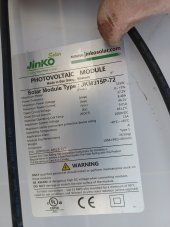Hello.
I modified a shipping container into a tiny home (maybe this should have been posted to Shipping Container Mods, but oh well) on some hunting land my family owns. We only went up for a couple nights a couple times a year so a generator worked well. We are now looking to spend more time up there and we're thinking about going solar. A friend had done some solar work on his property and had a few left over parts including 9 solar panels and a 5000w inverter. I'm trying to take advantage of what he gifted me and just need to figure out what other components are needed.
Panels *see photo: Jinko 315 watt × 9
(Should I run them all to a Combiner Box or run them in a series? Which is better?)
Combiner Box: ?? (I assume any will do provided it has enough connections and I'm not running my PV in series)
Charge Controller: ?? Please help me determine the correct specifications needed for this component.
Inverter: WZRELB 5000w 24v
Disconnect between combiner box and charge controller: ??
Disconnect between charge controller and batteries: ??
Battery meter: ?? I assume any will work?
And biggest question, BATTERIES. I want to be able to run 2000w for 8 hours.
I appreciate any kind words of advice and guidance.
I modified a shipping container into a tiny home (maybe this should have been posted to Shipping Container Mods, but oh well) on some hunting land my family owns. We only went up for a couple nights a couple times a year so a generator worked well. We are now looking to spend more time up there and we're thinking about going solar. A friend had done some solar work on his property and had a few left over parts including 9 solar panels and a 5000w inverter. I'm trying to take advantage of what he gifted me and just need to figure out what other components are needed.
Panels *see photo: Jinko 315 watt × 9
(Should I run them all to a Combiner Box or run them in a series? Which is better?)
Combiner Box: ?? (I assume any will do provided it has enough connections and I'm not running my PV in series)
Charge Controller: ?? Please help me determine the correct specifications needed for this component.
Inverter: WZRELB 5000w 24v
Disconnect between combiner box and charge controller: ??
Disconnect between charge controller and batteries: ??
Battery meter: ?? I assume any will work?
And biggest question, BATTERIES. I want to be able to run 2000w for 8 hours.
I appreciate any kind words of advice and guidance.
Attachments
Last edited:




